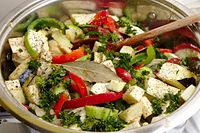Ratatouille
bay leaves and thyme | |
| Variations | Confit byaldi |
|---|---|
Ratatouille (.
Etymology
The word ratatouille derives from the
aubergine (eggplant), bell pepper, marjoram, fennel and basil. Instead of basil, bay leaf and thyme, or a mix of green herbs like herbes de Provence can be used. The modern version does not appear in print until c.1930.[5]
Preparation
The Guardian's food and drink writer Felicity Cloake wrote in 2016 that, considering ratatouille's relatively recent origins (it first appeared in 1877[unreliable source]), there exists a great variety of methods of preparation for it.[6] The Larousse Gastronomique claims "according to the purists, the different vegetables should be cooked separately, then combined and cooked slowly together until they attain a smooth, creamy consistency", so that (according to the chair of the Larousse's committee, Joël Robuchon) "each [vegetable] will taste truly of itself."[7]
-
Ratatouille niçoise
-
Raw ingredients
-
Heavily simmered and garnished with fresh parsley
-
Small pyramid (Confit byaldi)
Related dishes
Similar dishes exist in many cuisines. These include:
.In popular culture
In 2007,
Pixar Animation Studios released the film Ratatouille. The film features Remy, a young rat with an exceptional sense of taste and smell who dreams of becoming a chef. The climax of the film sees Remy prepare the titular dish in the form of confit byaldi for the notoriously harsh food critic Anton Ego, who unexpectedly loves the dish due to nostalgia
for his mother's cooking of traditional ratatouille. The movie gave widespread exposure to this dish around the world.
See also
- French tian
- List of stews
- List of vegetable dishes
- Shakshouka
- Lecsó
References
- ^ "Ratatouille". Oxford English Dictionary, 2nd edition (1989)
- ^ « ratatouio », Lou tresor dou Felibrige, Frédéric Mistral
- ISBN 978-0-19-967733-7.
- ^ "Chef Brian Discusses The Origin of Ratatouille Nicoise". LADC. Archived from the original on 2015-10-09.
- ^ Scotto, E., and Marianne Comolli. "Vegetables: A Garden of Eden." France, the Beautiful Cookbook: Authentic Recipes from the Regions of France. San Francisco: Collins, 1989. 195. Print."
- ^ Cloake, Felicity (15 July 2010). "How to make perfect ratatouille". The Guardian. Retrieved 9 September 2016.
- ISBN 978-0-307-26719-1.
External links
Look up ratatouille in Wiktionary, the free dictionary.





